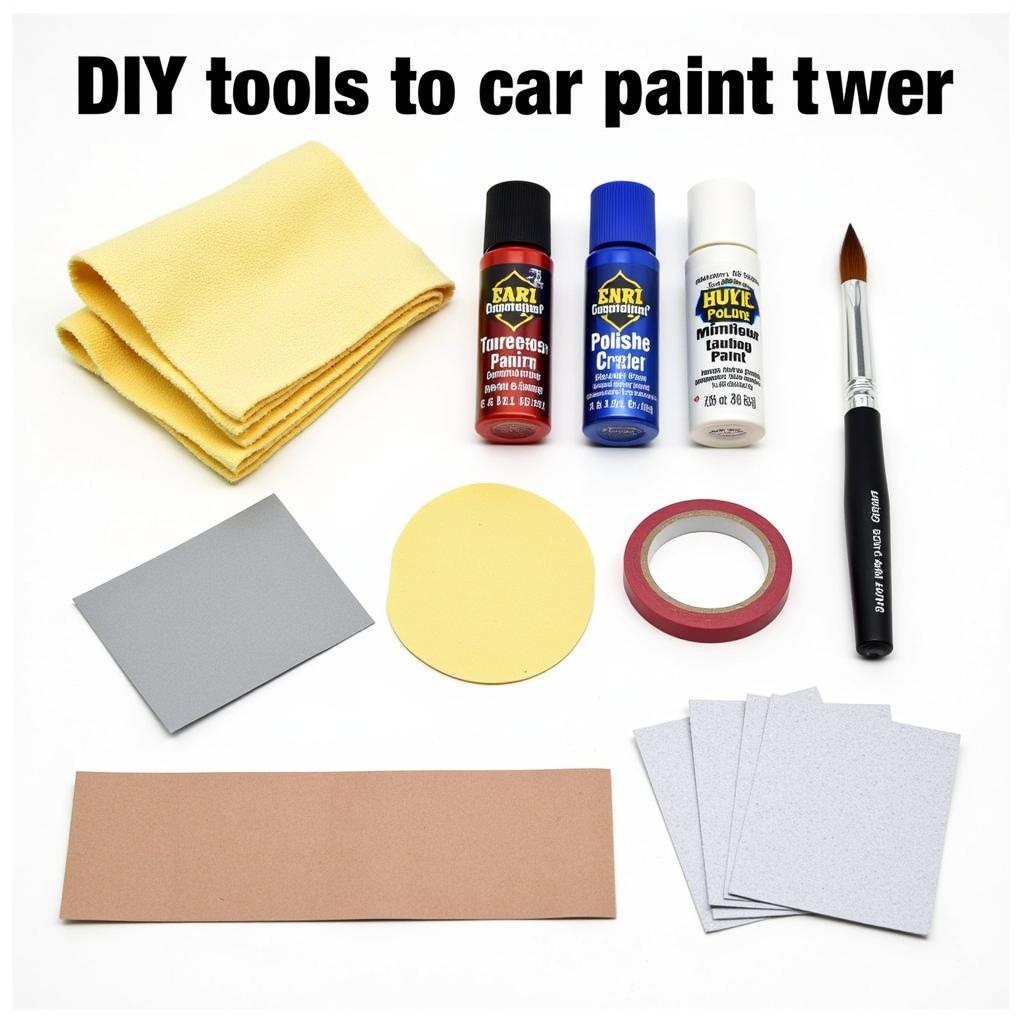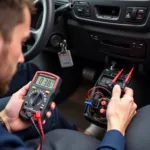Repairing minor paint damage for a car is often more straightforward than you might think, saving you both time and money compared to a professional body shop. This guide offers practical advice and expert tips to help you restore your car’s finish effectively.
Understanding the Different Types of Minor Paint Damage
Before diving into repairs, it’s important to understand the type of damage you’re dealing with. This will determine the best approach. Scratches, the most common type, range from clear coat scratches affecting only the top layer to deep scratches reaching the primer or bare metal. Stone chips are small, crater-like blemishes caused by road debris. Scuffs, often caused by bumping against another object, result in superficial paint transfer or removal. Understanding these differences allows you to select the appropriate repair method. Fixing a minor scratch yourself can be quite satisfying, especially if you’re looking to minimize the average car paint scratch repair cost.
Identifying the Severity of the Damage
Accurately assessing the depth and extent of the damage is crucial for a successful repair. A simple visual inspection can often reveal the severity. For scratches, run your fingernail across the affected area. If your nail catches, the scratch likely penetrates beyond the clear coat and requires more than just a simple polish. For stone chips, check for exposed metal, which indicates a higher risk of rust and necessitates prompt attention. If you’re uncertain about the best approach for your specific damage, researching car paint repair liverpool or best car paint repair bristol might give you some local professional options for assessment.
DIY Repair Methods for Minor Paint Damage
Repairing minor paint damage often involves simple techniques using readily available products. For light scratches and scuffs, a polishing compound can effectively restore the shine. Applying the compound with a microfiber cloth using circular motions will remove minor imperfections. Touch-up paint is ideal for deeper scratches and stone chips. Apply the paint carefully with a fine-tipped brush, ensuring precise coverage of the damaged area. For more significant damage, you might need to wet sand the area before applying touch-up paint to create a smooth and even surface. Knowing how to repair flaking car paint can be helpful if the damage extends beyond superficial layers.
Tools and Materials Needed for Minor Paint Damage Repair
Having the right tools and materials is essential for a successful DIY repair. Gather the following items before starting: microfiber cloths, polishing compound, touch-up paint (ensure a perfect color match), fine-tipped brushes, masking tape, sandpaper (various grits for wet sanding), rubbing compound, and a clear coat pen. Using quality products ensures a professional-looking finish and protects the repair from future damage.
“Accurate color matching is absolutely essential for touch-up paint,” says John Smith, Senior Automotive Technician at Precision Auto Body. “Even a slight mismatch can make the repair more noticeable than the original damage.”
Step-by-Step Guide to Repairing Minor Paint Damage
- Clean the area: Thoroughly wash and dry the damaged area to remove any dirt or debris.
- Assess the damage: Determine the type and severity of the damage.
- Apply polishing compound (for light scratches): Use a microfiber cloth and circular motions.
- Mask the area (for touch-up paint): Use masking tape to protect surrounding paint.
- Apply touch-up paint: Carefully fill in the scratch or chip with a fine-tipped brush.
- Wet sand (if needed): Use progressively finer grits to create a smooth surface.
- Apply clear coat: Protect the repair with a clear coat pen.
- Polish and buff: Restore the shine with polishing compound and a clean microfiber cloth.
Preventing Future Paint Damage
Protecting your car’s paint is crucial for maintaining its appearance and value. Regularly washing and waxing your car helps shield it from environmental contaminants and UV rays. Parking in shaded areas and using car covers can also minimize sun exposure and prevent scratches. Being mindful of your surroundings and avoiding close proximity to other vehicles in parking lots can prevent minor bumps and scrapes. For more information on repair costs, check out this helpful guide on how much does paint scratch repair cost on car.
“Regular waxing not only protects your car’s paint but also makes it easier to clean,” advises Maria Garcia, Automotive Detailing Specialist at Gleam and Glow Auto Spa. “It creates a barrier that repels dirt and grime.”
Conclusion
Repairing minor paint damage for a car is an achievable DIY project that can save you money and maintain your car’s appearance. By following the steps outlined in this guide and using the right tools and materials, you can effectively address minor scratches, chips, and scuffs. Remember to always assess the damage carefully and choose the appropriate repair method for the best results. Taking proactive steps to prevent future paint damage will keep your car looking its best for years to come.
FAQ
- Can I repair deep scratches myself? Deep scratches that reach the primer or metal may require professional attention.
- How do I match touch-up paint to my car’s color? Check your owner’s manual for the paint code or consult a dealership.
- What is the best way to remove scuff marks? Polishing compound is often effective for removing light scuffs.
- How long does touch-up paint take to dry? Drying times vary depending on the product, but generally allow several hours.
- When should I seek professional help for paint repair? For extensive damage or if you’re unsure about the repair process, consult a professional.
- What is the most common cause of minor paint damage? Road debris, minor collisions, and improper washing techniques are common causes.
- How can I protect my car’s paint from UV damage? Regularly waxing your car and parking in shaded areas can help protect against UV damage.
Need help with your car repair? Contact us via WhatsApp: +1(641)206-8880 or email us at [email protected]. Our customer support team is available 24/7.



